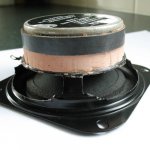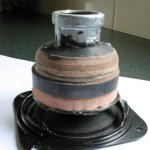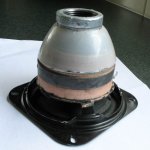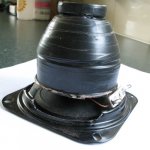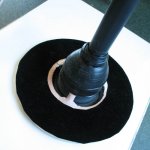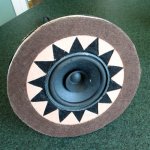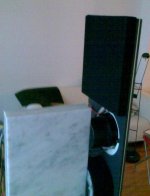Well how extreme do you want to go, here are some pics of a driver modded for open baffle application, the driver eventually goes into a panel but makes no contact with it being supported via a tube on the back of the magnet. The shaping of the rear of the driver, basket mods, stiffening the magnet to basket junction and damping all help regardless of the type of cabinet or non cabinet I have chosen to use. I hope it gives some help.
The pic on this post shows the driver with 3 legs cut out and the basket edge cut down, this on these small 4 inch drivers reduces congestion and makes for better bass as well. The magnet to basket junction is filled with builders bog, which is easily trimmed with a knife just prior to fully going off.
Cutting out basket legs on larger drivers might be asking for trouble however and it important to note these drivers are to be magnet mounted.
The pic on this post shows the driver with 3 legs cut out and the basket edge cut down, this on these small 4 inch drivers reduces congestion and makes for better bass as well. The magnet to basket junction is filled with builders bog, which is easily trimmed with a knife just prior to fully going off.
Cutting out basket legs on larger drivers might be asking for trouble however and it important to note these drivers are to be magnet mounted.
Attachments
This whole lot is screwed to a mounting tube and mounted on a felt covered sub baffle (this fits inside the main baffle without touching it, so no vibration is actually transferred to the main baffle).
If you look closely you will be able to see the driver legs have been shaped with filler for better flow and they are padded on the inside with felt, but this cannot be seen in the pic (sorry about that)
If you look closely you will be able to see the driver legs have been shaped with filler for better flow and they are padded on the inside with felt, but this cannot be seen in the pic (sorry about that)
Attachments
The front of the sub baffle has felt as well (thin in this case) and I quite like the look of it.
This driver is still far from finished, they then had dust cap mods, enabling, whizzer cone serrating and more. But hopefully it gives you a few ideas.
Cheers
Zero One
This driver is still far from finished, they then had dust cap mods, enabling, whizzer cone serrating and more. But hopefully it gives you a few ideas.
Cheers
Zero One
Attachments
Hi Adam
The basket is cut down using a dremel with a small abrasive cutting disc, I stuff cloth in around the cone to avoid damage and collect shavings. This works better than it sounds and I have cut down at least a dozen baskets this way. Any errant filings are picked up by using a small bit of cloth with vaseline on it.
Clearly you need to be very careful, it helps if the driver is held in a clamp so you can control the dremel with two hands.
The basket is cut down using a dremel with a small abrasive cutting disc, I stuff cloth in around the cone to avoid damage and collect shavings. This works better than it sounds and I have cut down at least a dozen baskets this way. Any errant filings are picked up by using a small bit of cloth with vaseline on it.
Clearly you need to be very careful, it helps if the driver is held in a clamp so you can control the dremel with two hands.
That's some pretty good stuff.
The idea of cutting some legs out to improve the wave path sounds logical.
Are these mods to correct for a specific parameter, calculation or measurement? Is that aerodynamic business exclusive to open baffle?
How did you detertmine it?
All mods should be stickied since they relate to the whole full range forum.
The idea of cutting some legs out to improve the wave path sounds logical.
Are these mods to correct for a specific parameter, calculation or measurement? Is that aerodynamic business exclusive to open baffle?
How did you detertmine it?
All mods should be stickied since they relate to the whole full range forum.
Hi gnugear:
On the felt it does a few things:
First up felt on the inside of the basket legs stops reflections of the legs back onto the cone, this in my experience makes a solid improvement in the mid range, especially on small drivers where the mids are able to be really well reproduced. Many smaller drivers have quite restrictive basket designs so the improvement is often better then expected.
Felt on the magnet and interface seems to help too, but is dependent on the enclosure type, for example in small boxes and horns etc the damping can stop lots of odd reflections around the rear of the driver, which will lead to clearer sound especially when you consider how thin the cone is on many full range drivers.
On an open baffle if is probably more important to get a smooth flow around the rear of the driver, so shaping the magnet area and using neoprene, which is reasonably smooth surfaced may be better.
Shaping the legs of the basket should smooth the flow as well, it stands to reason that sharp flat edged objects like pressed steel basket legs are not exactly the ideal.
The felt on the front baffle I feel reaps dividends with smaller drivers as it stops to a degree high frequency sound waves reverberating of the baffle in close proximity to the driver, this in my experience makes for better imaging and micro detail retrieval. It expect it will make less of difference on drivers with larger cones as the waves will be reverberating off the outer edge of the cones anyway which you can't do much about.
On cutting out the legs I can say it really does help on small drivers on OBs, when you think about it sound is reproduced from both sides of the driver but in most smaller drivers the rear cannot flow near as well as the front of the cone. To me it seems that this must confuse the sound somewhat as all sorts of little reflections come into play.
It is worth saying that I have actually made mods to drivers where all legs were removed and replaced with heavy gauge wire, the difference was substantial, stronger bass, clearer mids and smooth highs. The downside is keeping it all lined up and the loss of strength.
Cutting out 3 of 6 legs and damping and shaping the remaining legs is a good compromise.
As for how all this works for specific drivers is is very hard to say, basically I use the tweak and A/B with untweaked method.....a bit expensive probably but I play with cheap drivers so what the heck.
I would say the effects will always be more obvious on OBs as all other designs cause box reflections and pressure waves inside the cab which will negate much of the modifications benefits.
On smaller drivers the mods generally seem to remove a lot of the peakiness that exists in little full rangers, which to my ears makes for a smoother more pleasing sound.
On the felt it does a few things:
First up felt on the inside of the basket legs stops reflections of the legs back onto the cone, this in my experience makes a solid improvement in the mid range, especially on small drivers where the mids are able to be really well reproduced. Many smaller drivers have quite restrictive basket designs so the improvement is often better then expected.
Felt on the magnet and interface seems to help too, but is dependent on the enclosure type, for example in small boxes and horns etc the damping can stop lots of odd reflections around the rear of the driver, which will lead to clearer sound especially when you consider how thin the cone is on many full range drivers.
On an open baffle if is probably more important to get a smooth flow around the rear of the driver, so shaping the magnet area and using neoprene, which is reasonably smooth surfaced may be better.
Shaping the legs of the basket should smooth the flow as well, it stands to reason that sharp flat edged objects like pressed steel basket legs are not exactly the ideal.
The felt on the front baffle I feel reaps dividends with smaller drivers as it stops to a degree high frequency sound waves reverberating of the baffle in close proximity to the driver, this in my experience makes for better imaging and micro detail retrieval. It expect it will make less of difference on drivers with larger cones as the waves will be reverberating off the outer edge of the cones anyway which you can't do much about.
On cutting out the legs I can say it really does help on small drivers on OBs, when you think about it sound is reproduced from both sides of the driver but in most smaller drivers the rear cannot flow near as well as the front of the cone. To me it seems that this must confuse the sound somewhat as all sorts of little reflections come into play.
It is worth saying that I have actually made mods to drivers where all legs were removed and replaced with heavy gauge wire, the difference was substantial, stronger bass, clearer mids and smooth highs. The downside is keeping it all lined up and the loss of strength.
Cutting out 3 of 6 legs and damping and shaping the remaining legs is a good compromise.
As for how all this works for specific drivers is is very hard to say, basically I use the tweak and A/B with untweaked method.....a bit expensive probably but I play with cheap drivers so what the heck.
I would say the effects will always be more obvious on OBs as all other designs cause box reflections and pressure waves inside the cab which will negate much of the modifications benefits.
On smaller drivers the mods generally seem to remove a lot of the peakiness that exists in little full rangers, which to my ears makes for a smoother more pleasing sound.
ZBuff
Generally these drivers are meant to be magnet mounted, however I have mounted them in the conventional fashion as well and it worked fine. I Used epoxy attached to the remaining frame and it is fine, but really to get the strength the remaining frame needs a few small holes drilled where the wire is epoxied so as the key the epoxy to the frame better.
The ideal glue however is the 2 part liquid steel that I mentioned for attaching the magnet mounting blocks, this can be shaped and is extremely strong, I doubt strength would be an issue at all in this case, It is designed to be used in high stress applications and can be drilled, screwed and filed.
The main problem with replacing with heavy gauge wire is you have to do it in two parts, ie cut out 3 legs, glue up and let set properly, then do the other 3. Obviously if you don't do it this way you will have problems with voice coil alignment etc.
Generally these drivers are meant to be magnet mounted, however I have mounted them in the conventional fashion as well and it worked fine. I Used epoxy attached to the remaining frame and it is fine, but really to get the strength the remaining frame needs a few small holes drilled where the wire is epoxied so as the key the epoxy to the frame better.
The ideal glue however is the 2 part liquid steel that I mentioned for attaching the magnet mounting blocks, this can be shaped and is extremely strong, I doubt strength would be an issue at all in this case, It is designed to be used in high stress applications and can be drilled, screwed and filed.
The main problem with replacing with heavy gauge wire is you have to do it in two parts, ie cut out 3 legs, glue up and let set properly, then do the other 3. Obviously if you don't do it this way you will have problems with voice coil alignment etc.
Is this good for the Harvey?
This tweak for the OB would not work on shallow cabinets, but I'm
intrgued as to how it could be implemented in the Harvery design which Scott has in the Spawn series.
Scott can you comment on these tweaks?
The smoothing of the back wave should do something in a BVR but I
don't know the theory well enough.
This tweak for the OB would not work on shallow cabinets, but I'm
intrgued as to how it could be implemented in the Harvery design which Scott has in the Spawn series.
Scott can you comment on these tweaks?
The smoothing of the back wave should do something in a BVR but I
don't know the theory well enough.
I imagine it would be pretty hard to simulate the effects of this and the only way to tell would be to actually try it on a sacrificial driver. My expectation is that in a horn loaded type cabinet the effect would be not so great or maybe not even noticeable as the loading of the driver is important to the systems performance.
However I have done this to drivers used in internally ported double bass enclosures and the improved bass and clarity was very obvious.
I guess getting rid of early reflections off the frame and back onto the rear of the cone would have some positive effect in cleaning up the mids in a loaded enclosure....but I am only guessing.
However I have done this to drivers used in internally ported double bass enclosures and the improved bass and clarity was very obvious.
I guess getting rid of early reflections off the frame and back onto the rear of the cone would have some positive effect in cleaning up the mids in a loaded enclosure....but I am only guessing.
How I did it
I have a set of Coral Flat8 II's in some Voight horns I built long time ago....
When i first got these drivers and mounted them in the boxes, I noticed a rather unpleasant nasal coloration of the sound.
Uppon some investigation, i discovered that the "ringing" i got when tapping the stamped steel basket was in the same frequency range as the ugly coloration.
I had a sheet of that self adhesive bitumen stuff used for car body damping, and i cut out some strips of this which I then stuck on to the "legs" of the stamped steel basket.
This solved the problem perfectly!
Will probably work well on other drivers with stamped steel basket as well.
Good luck!
I have a set of Coral Flat8 II's in some Voight horns I built long time ago....
When i first got these drivers and mounted them in the boxes, I noticed a rather unpleasant nasal coloration of the sound.
Uppon some investigation, i discovered that the "ringing" i got when tapping the stamped steel basket was in the same frequency range as the ugly coloration.
I had a sheet of that self adhesive bitumen stuff used for car body damping, and i cut out some strips of this which I then stuck on to the "legs" of the stamped steel basket.
This solved the problem perfectly!
Will probably work well on other drivers with stamped steel basket as well.
Good luck!
Basket Damping
I prefer magnet mounting to reduce forces
on the basket and the baffle.
The stands of the system are made of
stone (marble) and the magnets are glued
directly to the stand.
For some more pics see
http://www.dipol-audio.de
Regards
I prefer magnet mounting to reduce forces
on the basket and the baffle.
The stands of the system are made of
stone (marble) and the magnets are glued
directly to the stand.
For some more pics see
http://www.dipol-audio.de
Regards
Attachments
- Status
- This old topic is closed. If you want to reopen this topic, contact a moderator using the "Report Post" button.
- Home
- Loudspeakers
- Full Range
- Basket, magnet & frame damping: How to?
